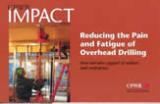Evaluating Interventions for Overhead Drilling (Completed – 2004-2009)
David Rempel, MD, MPH
University of California – San Francisco
San Francisco, CA
Ph: (510) 665-3403
[email protected]
Dr. Rempel developed and refined the device by working with building trades unions and contractors. The device has received rave reviews from workers, who report more comfortable postures, as well as reduced muscle fatigue and hand vibration while using the device. Now the research team has data to validate the workers’ subjective responses. The team measured ergonomic factors such as force and musculoskeletal strain, with and without device, and found that the device frequently outperformed the usual drilling method. For instance, the average hand forces measured during drilling with the overhead device were about 10 times less than hand forces with the traditional drilling method. Another measurement showed how the device reduces shoulder muscle strain and fatigue: the percent time with the shoulder flexed or abducted stretched to greater than 60 degrees was 21% with the device, compared to 40% with the usual drilling method. Also, there was significantly less head exten-sion with the device compared to the usual method.
Dr. Rempel and his research team have been seeking collaborators to bring this product to market. Now that dream is coming closer to reality.
Cupertino Electric, a regional contractor, has recently invested resources in improving the device design and plans to build many of the devices so that they will be available at all of their construction sites. This electrical contractor employs 900 to 1,600 electricians (IBEW Local 332). Cupertino Electric was introduced to the device at one of Dr. Rempel’s presentations to the National Electrical Contractors Association. Their fabrication department has modified the device design and developed what they call the Upside Down Drill Press. They have also developed a light-weight version of the device for use in a scissor lift, called a Pogo-stick Upside Down Drill Press.
The modified devices have received positive reviews by several construc-tion workers. Cupertino Electric is interested in working with Dr. Rempel to formally evaluate the two new designs on construction sites.
Trials of the device have been so positive that many contractors in addi-tion to Cupertino Electric have asked to purchase the tool. Dr. Rempel receives an average of two enquiries a week about how to obtain the device. He currently works with a small tool fabricator who produces one or two devices each month.
Original Project Abstract:
For construction workers, repeated overhead drilling into concrete or metal is one of the most physically demanding tasks at work; a task associated with elevated rates of shoulder pain and disorders. The purpose of this study is to develop and evaluate various interventions to assist with overhead drilling in order to reduce shoulder load. In Phase 1 of the study, three assist devices will be used over one day in the field by 20 construction workers. The devices will be modified to address identified limitations and the evaluation and modification process will be repeated. In Phase II, the best 2 devices will be evaluated against the usual method for overhead drilling by 120 construction workers when they perform 3 days of overhead drilling in the field. The construction trades studied will be plumbers, electricians, and sheet metal workers. Outcome measures will be shoulder pain rating, shoulder posture, electromyography of shoulder and forearm muscles, tool vibration, device usability and work productivity. Cost-benefit analysis will be performed. In Phase III, the study findings will be disseminated nationwide. This phase will involve assembling a Dissemination Advisory Committee which will design and oversee the implementation of a dissemination plan directed to construction workers who perform overhead drilling, related contractors and tool purchasers, tool manufacturers, and construction health and safety professionals. It is anticipated that the study will identify overhead drilling interventions that will reduce shoulder pain and shoulder load and improve productivity and effectively disseminate this information nationwide.
